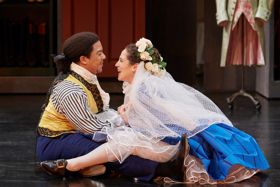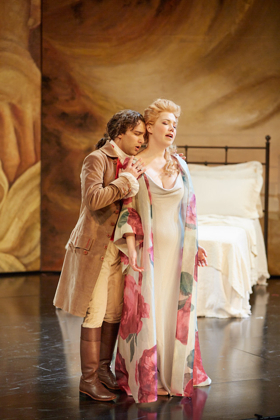Review: FIGARO is Brilliantly Married in St. Louis

Opera Theatre of St. Louis has opened its 44th festival season. This is St. Louis' prized centerpiece of opera, with a world-wide reputation. It is famous for its superb productions. The company's home is the beautiful and comfortable 763-seat Browning Theatre at Webster University. Gourmet picnic suppers may be enjoyed before the show on the lovely grounds of the theater. All operas are performed in English with super-titles.
The weather was kind to us Saturday as we supped al fresco before the show. The season opener was a splendid production of Mozart's The Marriage of Figaro. This is Mozart at his best and it is a deeply beloved work. (It is the ninth most frequently produced opera in the world.) The capacity crowd seemed especially animated and receptive.
We enter the theater and find ourselves awash in Fragonard! Remember? That elegant French lady with simply oceans of petticoats up in a swing? Well, stage director Mark Lamos and set designer Paul Steinberg have chosen to encase this Figaro in images from Fragonard-close-ups of beautiful faces, rosy pink bodies-a kind of soft-edged Rococo Valentine eroticism. Jean-Honoré Fragonard was a contemporary of Mozart's so his dreamy views of the erotic world of the nobility are utterly appropriate to this elegant 18th century operatic sex farce.
The Fragonard feeling is also present in the magnificent costumes designed by Constance Hoffman. In general line and cut they are true to the fashion under Louis XVI, but Ms. Hoffman takes daring, exciting-and lovely-liberties with fabric and color. There are very large floral patterns on coats and gowns. The countess once appears in what I can only call high-fashion Capri pants under an open-fronted flowing gown. This is the glamorous look of Hollywood, of Harper's Bazaar, not of Mozart's Vienna or Figaro's Seville, but if those 18th century nobles had thought of that look they would have used it.
under an open-fronted flowing gown. This is the glamorous look of Hollywood, of Harper's Bazaar, not of Mozart's Vienna or Figaro's Seville, but if those 18th century nobles had thought of that look they would have used it.
Our story is set in the palace and garden of Count Almaviva. This is perhaps three years after the count had won the hand of Rosina with the help of his clever servant Figaro. Now Figaro is soon to marry the charming Susanna, lady's maid to the Countess Rosina. But, alas, there are complications. The count, having become bored with married life, is directing his lustful attentions to Susanna.
Amidst all this is Cherubino, a young man-an adolescent, really-who is a bit of a loose cannon, driven by hormones into mad infatuation with almost every woman he meets-including his godmother, the countess. Cherubino's response to Cupid's darts is adorably innocent, in contrast to the count's darkly shaded mature sexual pursuits.
Comedy ensues in the complex machinations of the betrothed, the countess, and Cherubino to frustrate the sexual ambitions of the count-a man who feels (and literally is "entitled"). How can they deliver an unsullied Susanna to the altar?
The great Fragonard panels of the set move about gracefully from scene to scene. At the opening of Act 1 they reverse themselves to present the room assigned as bedroom for the newlyweds. It's what used to be called a "lumber room" and it's wonderfully detailed-full of old luggage and flower-pots and boxes and busts and figurines and lamps and shoes by the dozen.
All of that is the world we see. But we really came to hear. And the voices in this stella r cast do not disappoint. Several are old friends on the OTSL stage. Most remarkable, I think, is soprano Susanna Biller as the countess. Hers is a flexible talent: on this stage she has sung for us the lovely Adina in Elixir of Love, the royal fiancée in Richard the Lionheart, and the hunch-backed nymphomaniac maid in Kafka's The Trial. In Figaro she returns to nobility (which is her natural element). Her voice, throughout its range, shows a silvery-smooth beauty and such easy, effortless power! At the opening of Act 2-alone in her bedroom, surrounded by all that soft, rosy Fragonarderie-her aria pleading with the gods of love to return the count's affections to her is stunningly lovely.
r cast do not disappoint. Several are old friends on the OTSL stage. Most remarkable, I think, is soprano Susanna Biller as the countess. Hers is a flexible talent: on this stage she has sung for us the lovely Adina in Elixir of Love, the royal fiancée in Richard the Lionheart, and the hunch-backed nymphomaniac maid in Kafka's The Trial. In Figaro she returns to nobility (which is her natural element). Her voice, throughout its range, shows a silvery-smooth beauty and such easy, effortless power! At the opening of Act 2-alone in her bedroom, surrounded by all that soft, rosy Fragonarderie-her aria pleading with the gods of love to return the count's affections to her is stunningly lovely.
Susanna (Figaro's Susanna, not Miss Biller) is a tour de force role, and Monica Dewey triumphs in it. (Last year, in Regina, she sang the role of Alexandra, the daughter.) Such a large, lovely voice in such a small frame. And she convinces us that this lowly servant girl is cleverer than anyone else on stage.
Aubrey Allicock makes a robust, engaging Figaro, fiercely committed to foiling the count's plans. He's vocally rich and strong, though the very lowest notes just nudge the bottom of his tessitura-that vocal sweet-spot.
Count Almaviva is sung by the strikingly handsome Theo Hoffman, who was born to wear those elegant costumes. (Hoffman sang the role of Joseph K. in The Trial.) His is an ardent and graceful performance, though a physically larger man would have given the count a bit more menace.
Opera Theatre h as such great success in casting their "breeches roles"-those roles in which handsome young women are presented as beautiful young men. Mezzo-soprano Samantha Gossard gives Cherubino a bright youthful energy. She is lean and a little gangly-as if her adolescent limbs had only recently grown suddenly long. And her voice is sublime.
as such great success in casting their "breeches roles"-those roles in which handsome young women are presented as beautiful young men. Mezzo-soprano Samantha Gossard gives Cherubino a bright youthful energy. She is lean and a little gangly-as if her adolescent limbs had only recently grown suddenly long. And her voice is sublime.
Other excellent work is done by Nathan Stark as the very comic Dr. Bartolo, by Mary Ann McCormick as Marcellina, John McVeigh as the brisk (and slightly "swish") Don Basilio, Phillip Lopez as Antonio, Elena Villalón as the mischievous Barbarina and Calvet Young as Don Curzio, the lawyer. Diction is splendid throughout-perhaps especially in McVeigh's Don Basilio and Stark's Bartolo.
Conductor Christopher Allen maintains a lovely balance in his fine orchestra. He also plays harpsichord for the recitatives.
Stage Director Mark Lamos guides his cast deftly throughout the evening, though there are moments when the action lacks a little of the frenzy that farce demands; where the physical movement is legato rather than the presto that comedy requires. The scene where the ladies disguise Cherubino as a woman should have been a riot-I mean corsets are just funny, after all. But it is too leisurely, too simply done.
There were a handful of design elements that puzzled me, too. Cherubino's first costume was particolored-almost Harlequinesque. And Barbarina, his amor-du-moment, could have been Columbine; she was just strangely dressed.
The two largest Fragonard images are softly beautiful but bizarre. One shows a violent bedroom assault. In the other a lovely reclining nude is shown with a sturdy arrow shaft piercing her chest. And blood! It's simply gory. The gore is a soft dark rose, not a brilliant scarlet (that's in Rigoletto-stay tuned). Now, I know Cupid uses arrows but aren't they slender and bloodless? This image is more suitable to St. Sebastian than to Mozart.
Ah, well. These are quibbles. The Marriage of Figaro at Opera Theatre of St. Louis is another in their long line of brilliant operatic successes. It continues in their festival calendar through June 29.
(Photos by Eric Woolsey)
Reader Reviews

Videos

